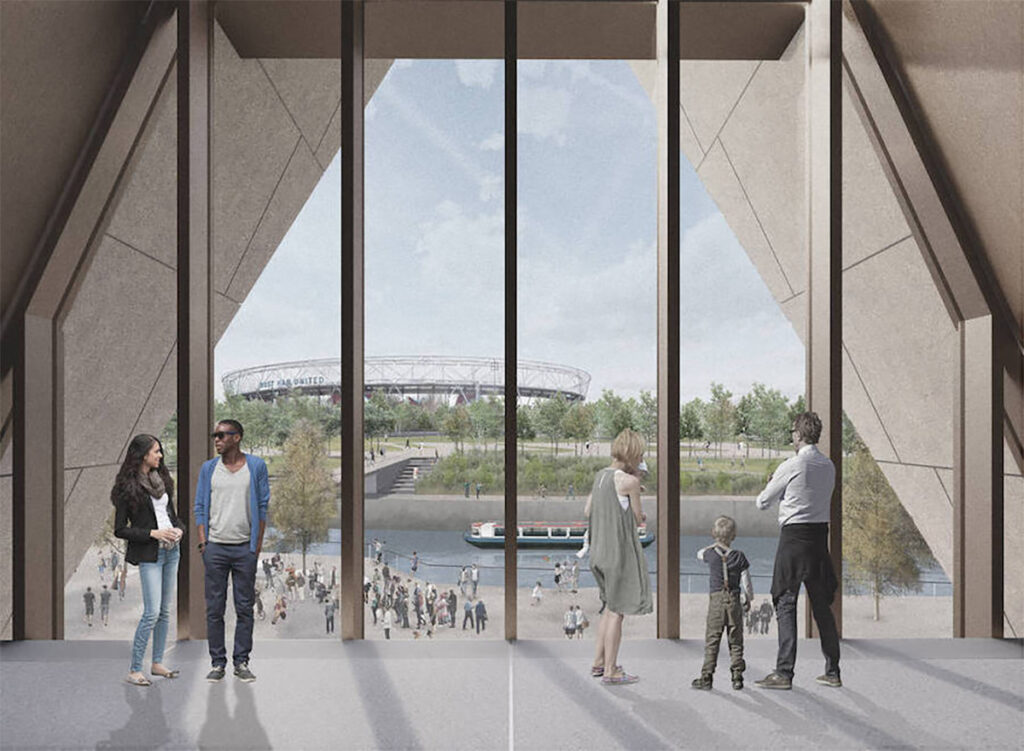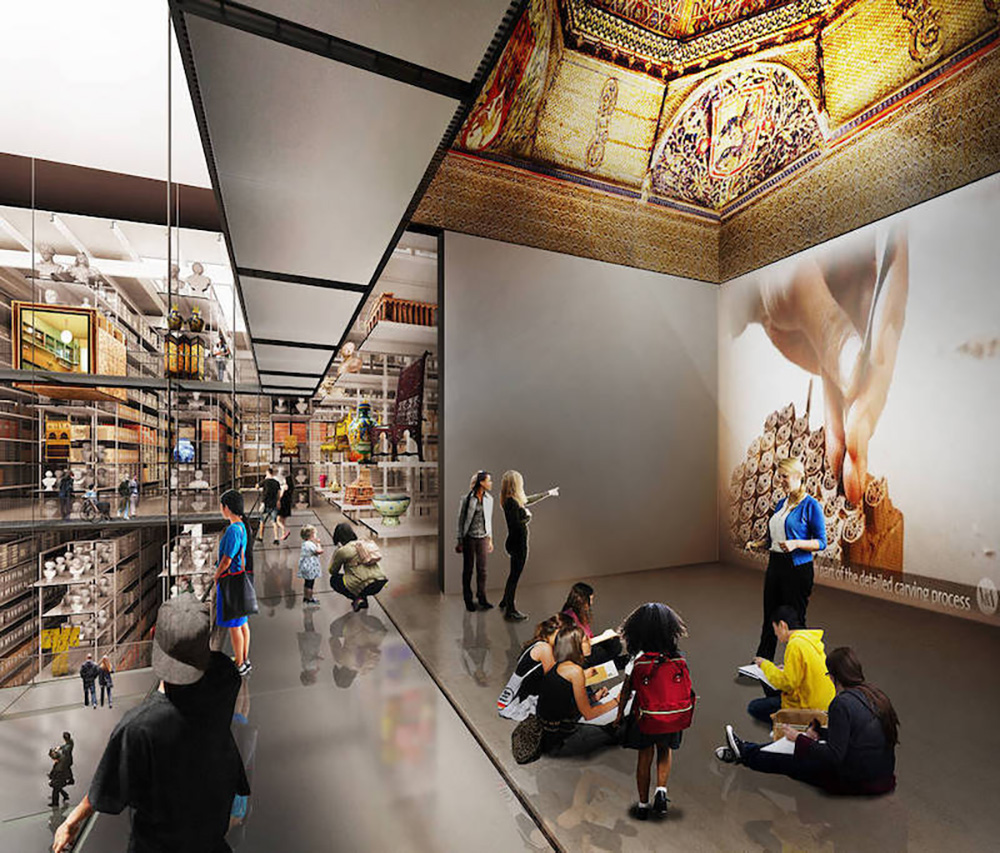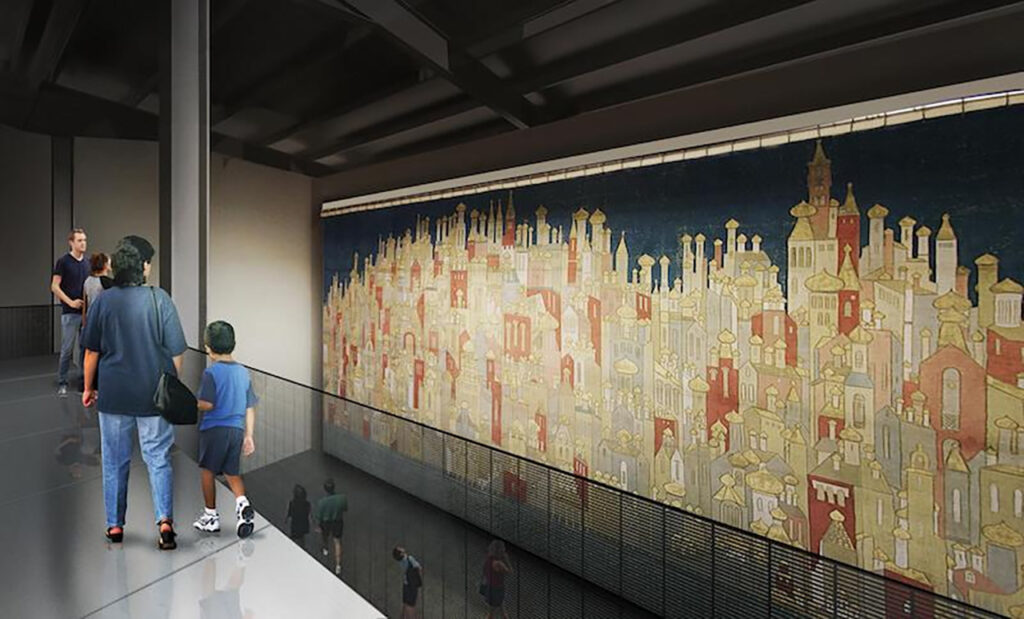This article originally appeared on blooloop, our content partner. Read the first part of the story here.
The Victoria and Albert Museum in London is currently being transformed by the ambitious FuturePlan project which includes the creation of a new museum and a new collection centre – the V&A East.
The museum will use its reserve collection to create a new type of museum experience at V&A East, not just accessible storage, says Tim Reeve, Deputy Director of the V&A.
“Having those two things working together will be a very powerful and unique proposition. Bringing the collection, bringing the objects, bringing this amazing legacy to Stratford and opening it up. Because it is intended to be and was brought together to be a source of inspiration. What we describe as this creative sourcebook. To open it up in that part of London is laden with possibility.”
Reeve says that a project of this scale and ambition needs a strong creative vision, in order to truly resonate with its target audience. This is where Casely-Hayford comes in.
Dr. Gus Casely-Hayford left his position at the Smithsonian National Museum of African Art to work on the V&A East project. Talking about what attracted him to the development, he says: “In part, it is the reputation of the incredible team at the V&A, Tim and Tristram [Hunt] and that incredible curatorial team. To feel that one could join that team, at this moment, it was just an enormous pleasure. I feel incredibly blessed.”
Starting a dialogue through the V&A East
Casely-Hayford is excited about the potential of the V&A East project: “It is an incredible new proposition for two new buildings, but also our amazing collections. What we want to do is to create an interface with our audiences and our local communities. One that will feel two-way. We want this to feel like their space. And them being in it will be the thing that animates the space, that brings it to life.
“It’s not just buildings, not just objects. It objects which come to life through a kind of dialogue with the local communities. That dynamism, that electricity, the interaction between community and object and space is what we want to see come to life in the two-building proposition of V&A East.”
“It’s difficult to describe the building,” adds Reeve. “It’s quite easy to get drawn into quite tired, well-worn ways of describing this sort of adventure. We can use the words immersive, open display, public, open storage, and those sorts of things.
“But the idea at V&A East, and we selected the right architect, the right building and the right part of the Olympic Park for this, was to design something that brought people right into the middle of the collection.”

Internal render view of the new V&A museum at Stratford Waterfront, designed by O’Donnell + Tuomey. Image: © O’Donnell + Tuomey / Ninety90, 2018
Exploring the collection
“What this will be, as well a different type of museum experience, is a real working logistics centre for the V&A collection,” says Reeve. “Objects will come and go. They will be conserved or they’ll go on tour or they’ll need to go off display because they can’t take too much light and so on.
“The word immersive can sound a bit hackneyed. This is about bringing the public and the collection closer together and to allow a different set of interactions to arise from that.”
“You can access collections in most public museums,” says Casely-Hayford. “But you might need a PhD or letters of recommendation. And once you get in, you probably have to navigate other additional layers of bureaucracy and security. Then, you might then be able to view the objects. But it probably won’t be in the most comfortable physical circumstances.”
“What we want to do is to change that completely. Our collections are held in trust for the public, they belong to all of them. And we want to offer them back to the public.
“So it is this giant box, within which you are placed right into the centre of the collection. You will be able to stand in the collection at the very centre of the building. There is a huge glass atrium, with a glass floor and glass balustrade.
“You can stand in the centre of the building and see most of those 250,000 objects from a single spot. Here, you will have a sense of the complexity, the breadth and the diversity of this collection. As well as the directions of potential investigation that you could potentially go on.
“It’s a point which is sort of equalizing, whether you are an academic, whether you’re an artist, whether you are a young child who’s coming for the first time into the collection centre. This will be something which conveys the sense of the possibilities and the manifold stories that you can tell through our collection.”

Internal render view of V&A CRC at Here East, with Altamira Palace ceiling. Image: © Diller Scofidio + Renfro, 2018
Engaging with the V&A East
“What I’m hoping is that that proposition, that invitation, will then activate in the minds and imaginations of our visitors, a sense that this is the space in which we want them to add their own stories, to iterate the interpretation with their own contributions,” says Casely-Hayford.
“They can do that through digital engagement, through social media. They can tell us what our objects and what our space makes them feel.
“These objects aren’t just to be held in aspic and to be contained by academic interpretation. They are things which were made with love and care and thought. So we want to reactivate that love and that care through interaction with the public.”
“We want this space to be somewhere that you come and visit, and you leave behind something of yourself. As well as taking away, hopefully, something which changes you.
“Over a period of months and years, we will accrete, along with all of the visits and the memories, a body of interpretive history that will demonstrate something of how this repository is not just something which is held in aspic, but which is constantly changing because of the way in which it’s dynamized by these visits.
“I think that is something which we lose with museums, the sense that they are spaces of continual transformation. Not just of people, but also of the narratives that surround the institution. We want to be able to capture that dynamic. We want to be able to engage people across the world digitally in helping us to think about what objects might mean. Both to the people who create them and to those who use them.”
Future collaborations
The V&A East project also gives the institution a chance to collaborate with other organizations. “We’re on a park with the BBC, and with UCL [University College London] who we have signed an MOU with,” says Casely-Hayford. “We’re going to collaborate with them on doctoral theses and research, which is exciting.”
“But we also want to find ways of collaborating with Sadler’s Wells and London College of Fashion. And then further afield, with other institutions across Britain and also to look at international collaborations
“It is really important for us to find ways of bringing other voices to this bit of London. We want to become a window on the world, a way in which we can travel and engage with contemporary and historic practice from right across the globe. And we want to engage with it in ways that will mean that people can come and they can leave a little bit of themselves behind. They can tell us what they think about these places and their experiences.”

The new location will have the space to display rarely seen items from the collection, such as this 15-metre-wide theatrical backcloth designed by Natalia Goncharova for the 1926 Ballets Russes London production of Stravinsky’s Firebird.
A desire for change
“Look at how Gen Z are interacting with the world. They want to see change. They want to feel that their generation will not leave behind the same problems that they’ve inherited,” says Casely-Hayford.
“We want to create a space in which they can see, through a cultural lens, a way in which they can contribute, in which they can shape their own futures but also the futures of others.
“I think it’s an exciting time and it’s the right place in which to do this. It is one of the most diverse and culturally interesting parts of London, but also one of the most creative. I think if we bring all of these constituent parts together, we can step away. Or we can just allow the way in which people use creativity to dynamize conversations. We can allow it to transform our spaces.
“That’s the really exciting thing, this isn’t about us imposing on others what they should think. It’s about others coming into our spaces, making something of themselves and making something of our spaces which wasn’t otherwise there.”
The power of art
Both Reeve and Casely-Hayford believe that art is something which has the power to both transform people’s experiences and to provide comfort. Particularly in such a challenging year.
“I find it very difficult to single out a favorite object,” says Reeve, of the V&A’s collection. “It’s a different one on a different day of the week. For me, one of the special things about working here is the spaces, and the ability to drift from one space to another. For instance, from European sculpture into religious sculpture into glass or silver or Renaissance.”
“We talked about the sort of tone and atmosphere of spaces. I can see and indeed feel it myself, even still from time to time, that some of the public spaces at the V&A can be quite forbidding, because of the scale and the volume and the grandeur. But at the same time, I find it quite comforting and almost cosy to be there.
“So for me, it’s that variety and it’s the objects in the spaces that have been designed to house them. Because of the depth and the breadth of the collection, that kind of history almost just sort of seeps into you. For me, that’s more important than a single object.”



